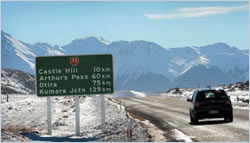In implementing the NLTP in the next three years to 2011/12, the NZTA will:
Variations to the NLTP will be managed through a monthly review process, and result from three sources:
Most variations are expected to be transfers of allocations between activity classes to fund unbudgeted expenses on emergency works or to transfer funds from an under-spent activity class to one where they can be used for high-priority activities. Funding approvals will only increased in exceptional circumstances.
Variations proposed by local authorities or regional transport committees generally relate to:
Changes to the status of activities already in the NLTP, or their cost estimates or programming, are not considered variations because they arise either during the normal course of events in preparing and implementing activities or through updates to information. They are managed directly between the NZTA and the relevant programme managers.
When considering proposed variations to this NLTP, the NZTA will generally follow the same processes as those used in developing and adopting it. If a proposal has enough priority considering the funds remaining to be allocated in 2009-2012, and the other activities in the NLTP, it will be added to the NLTP. The associated funding request will be considered in the same way as other funding requests for activities listed in the NLTP.
It may be necessary to vary the NLTP if local authorities' annual plans (adopted in mid-2010 and 2011) contain significant changes to transport activities to be funded through the NLTP. Significant funding decisions and variations made to the NLTP will be posted on the NZTA's website at www.nzta.govt.nz(external link).
The NZTA will consider funding proposals for NLTP category 2 projects as part of its monthly review cycle during 2009-2012. Most will be managed by NZTA regional offices directly with the relevant local authorities to simplify procedures and ensure prompt responses.
Funding approval for activities that are funded through a group allocation will be managed through NZTA's regional offices. The activity tables included in each regional document show the likelihood of funding approval for category 2 activities taking into account their indicative priority and the funding a available within each activity class. An activity has been given a reserve status if it has an indicative priority which makes it unlikely to be funded.
The NZTA's assessment framework will be used to:
The NZTA expects to be able to fund category 2 projects in 2009-2012 if they are submitted for funding approval at the rate that has occurred in the past. If this rate increases, or project costs increase or revenue falls, the NZTA may need to programme projects later than proposed.
In developing the NLTP, the NZTA is required to ensure that:
The main risks to delivering the NLTP are:
Because revenue and expenditure may differ from budget, the NZTA must carefully monitor and manage revenue and expenditure in 2009-2012 to meet the GPS's financial targets. During 2009-2012 it expects to work with each approved organisation to review progress on implementing proposed activities and forecast expenditure. This process will ensure that:
This NLTP allocates multi-year funding for many groups of activities in order to streamline funding administration and give local authorities funding confidence.
Multi-year funding comprises almost 60 percent of the NLTP's anticipated expenditure for five groups of activities:
Thirty percent of the NLTP is allocated to large state highway projects, 7 percent to large public transport infrastructure and local roading projects, and the remainder to other activity classes.
Because such a large proportion of expenditure goes to multi-year funding for groups of activities, it's important to ensure that it's spent as expected and, if programmes fall behind, that opportunities are identified and seized to use available funds for other high-priority projects.
Stand-alone projects implemented over several years are given funding approval for their expected costs, with expected annual cash flows.
Expenditure is generally expected to match the annual cash flow budgeted for multi-year groups of activities and for projects, with only minor variations in cash flow between years. However, if progress is significantly delayed in any year, the NZTA will agree to carry forward unspent cash flow after considering whether:
The NZTA will periodically review allocations to activity classes to ensure the funding available is targeted at the highest-priority projects and the NLTP remains affordable. This could result in changes to the funding allocated to activity classes - especially funding not yet committed to particular activities. When reviewing allocations, the NZTA will consider:
The NZTA supports using supplementary funds to expand the rate at which high-priority projects in the NLTP can be implemented. It is pursuing tolling opportunities (such as that used for the Northern Gateway Toll Road) so that projects can be advanced.
The NZTA has little direct control over NLTF revenue. Instead, if there is a material change in anticipated revenue for the NLTP, it adjusts the allocations to activity classes unless other funding sources are available.
The NZTA welcomes funding proposals for projects that use supplementary funding sources, particularly for its work on the state highway improvement programme (see page 33).
The NZTA expects those best able to control cost risks to manage them. This means the NZTA takes responsibility for managing cost risks for the state highway programme, and expects local authorities to manage the risks for their programmes.
Programme managers are expected to control projects' scope so that costs don't change from those given funding approval. Note that approved funding is not indexed against inflation because the NZTA has little scope to do this; instead, programme managers are expected to deliver activities within the funding provided.
Any significant changes will be shown on the NZTA's website at www.nzta.govt.nz(external link).
Last updated: 6 October 2009